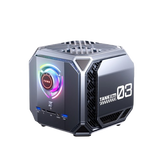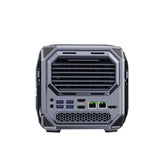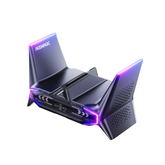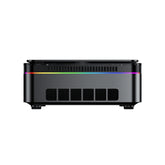Which Invention Allowed Computers to Become Smaller in Size?
Due to the ever-evolving nature of technology, the question lingers: Which Invention Allowed Computers to Become Smaller in Size? That might be the dawn of IC IC chips. This brought a change in the very nature of cloud computing and revolutionized the tech industry, allowing computers to be smaller, faster, and more efficient.
As a consequence, computers are now widely available, and some smart things can help us make various daily decisions. Let's embark on a journey through the annals of innovation and explore the pivotal advancements that led to the compact marvels we now call Mini PCs.
The Revolution Begins: Microprocessors Take Center Stage
In the quest for compact computing, the emergence of microprocessors was a game-changer. These tiny chips, often considered the brains of computers, replaced bulky vacuum tubes, paving the way for a significant reduction in size without compromising performance.
The "available power" made possible the creation of exceptional small and mobile machines like laptops, tablets, and mobile phones. The spark of microprocessors opened up immense uncharted potential for the evolution of technology and still continues to define the way we interact with immaculate technology.
Transistors: The Silent Architects of Miniaturization
Enter the era of transistors, the unsung heroes behind the downsizing of computers. These minuscule semiconductor devices replaced larger and less efficient components, contributing to a remarkable reduction in size while enhancing efficiency and speed.
Transistors allowed computers to become smaller, more powerful, and more reliable. They also had the benefit of being relatively cheap and could even be produced on a large scale. This made them an essential tool for the miniaturization of technology.
Integrated Circuits: Crafting a Compact Symphony
The integration of multiple transistors on a single chip marked the birth of integrated circuits. It not only allowed the normalization of the production procedure, but also it turned out to be an important thing in making computers even more compact and more advanced.
Instead of wasting space, it made it possible to do everything in one go, dramatically saving resources. Besides that, it unlocked more computational speed, permitting people to do more operations than before.
Magnetic Storage: Shrinking the Space, Expanding the Possibilities
As the need for smaller yet more capable computers grew, magnetic storage stepped in. Compact hard drives and storage devices replaced their bulkier counterparts, allowing for a significant reduction in overall size without sacrificing storage capacity.
With compact hard drives and storage devices, users were able to store and access larger amounts of data, making it easier to handle complex tasks and projects. This advancement in storage capacity greatly enhanced the efficiency and speed of computers, further propelling technological advancements.
The Rise of Solid-State Drives (SSDs)
Solid-state drives revolutionized data storage by eliminating moving parts, offering faster performance, and contributing to the overall diminution of computer size. The shift from traditional hard drives to SSDs was a defining moment in the pursuit of compact computing.
ACEMAGIC Mini PCs: Redefining Compact Excellence
In our contemporary landscape, ACEMAGIC Mini PCs stand as a testament to the relentless pursuit of compact excellence. These cutting-edge devices encapsulate the culmination of decades of technological advancement, providing users with powerful computing in a sleek and compact form factor.
The ACEMAGIC Advantage
ACEMAGIC Mini PCs are not just about size; they embody efficiency, speed, and versatility. With state-of-the-art components and innovative design, these mini powerhouses deliver a computing experience that rivals their larger counterparts.
Power in the Palm of Your Hand
Experience the freedom of space without compromising on performance. ACEMAGIC Mini PCs empower users to have a compact computing solution that fits seamlessly into any environment, whether it's a home office, entertainment center, or professional workspace.
Future-Forward Innovation
ACEMAGIC's steadfast dedication to innovation ensures that users stay ahead in the ever-evolving tech landscape. These Mini PCs are not just compact; they are a glimpse into the future of computing, where power meets portability.
Wrap Up!
The journey of computer miniaturization is a testament to human ingenuity. From the advent of microprocessors to the sleek ACEMAGIC Mini PCs of today, each step has been a leap toward efficiency and compact brilliance. Embrace the future with technology that fits in the palm of your hand, courtesy of ACEMAGIC.
FAQs
What is a Transistor in a Small Computer?
A transistor in a small computer is a fundamental electronic component that acts as a switch or amplifier. In compact computing devices, transistors are crucial for processing information, enabling the miniaturization of electronic circuits and contributing to the overall reduction in computer size.
How Does a Transistor Work?
Transistors operate by controlling the flow of electrical current. They consist of semiconductor materials that can be manipulated to allow or block the flow of electrons. By applying a voltage to the transistor, it can be switched on or off, serving as the building block for digital logic circuits in computers.
What is SSD?
SSD stands for Solid-State Drive. It is a storage device that uses NAND-based flash memory to store and retrieve data. Unlike traditional Hard Disk Drives (HDDs) with spinning disks, SSDs have no moving parts, providing faster access times, improved durability, and enhanced overall system performance.
What is NVMe SSD?
NVMe (Non-Volatile Memory Express) SSD is a type of solid-state drive that connects to a computer via the NVMe interface. This interface allows for faster data transfer rates and reduced latency compared to traditional SATA connections. NVMe SSDs are known for their exceptional speed, making them ideal for high-performance computing tasks.
What is the Difference Between SSD and HDD?
The main difference lies in the storage technology. HDDs use spinning magnetic disks to read and write data, while SSDs use flash memory. SSDs offer faster data access, are more durable due to their lack of moving parts, and generally consume less power compared to traditional HDDs.







Leave a comment
Please note, comments need to be approved before they are published.